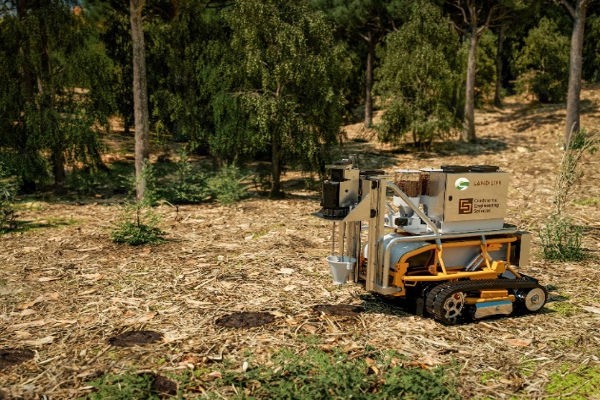In an effort to slow down the effects of deforestation, Continental and the nature restoration firm Land Life are creating a tree-seeding robot. The tree-seeding robot can plant up to 60 pit in the ground in an hour, with the robot having the capacity to sow one tree seed every minute. This makes it an especially practical and long-lasting method of replanting in areas impacted by ecological damage.
Together, Land Life and Continental Engineering Services (CES), the company’s in-house engineering and development services provider, will launch this ground-breaking robot onto the market.
Based in the Netherlands, Land Life has been instrumental in reforestation and renaturation products. The company will provide its extensive knowledge of nature restoration initiatives.
The automatic drilling and seeding module for planting the seed balls, on the other hand, is being developed by CES. The autonomous driving unit that transports the robot is a robot vehicle made by the German business Stella Engineering, which is now on the market.
“We are pleased to partner with Land Life to jointly develop a sustainable solution for the preservation and protection of vital ecosystems,” says Martin Poettcher, Head of Business Center GreenTech at CES. “We have adapted the robot to our proven, robust automotive technology so that it can operate in an automated and safe way, even in rough terrain. Our collaboration will clearly benefit the environment.”
The Increasing Global Forest Loss
The World Resources Institute (WRI) said in a monitoring study that the amount of forest loss worldwide increased by 24% in 2023, from 22.8 million hectares in 2022 to 28.3 million hectares. There is a major loss of tropical rainforests.
Approximately 37,000 square kilometers, or 3.7 million hectares, of forest area—much larger than Belgium—vanished in total in 2023. Over the past 20 years, the WRI estimates that three to four million hectares of tropical forest have been destroyed worldwide.
Mature rainforest areas are especially significant for biodiversity, carbon sequestration, and controlling local and regional climate effects.
The need to restore ecosystems is greater than ever, given the severe consequences of climate change, which include continuous forest cutting and forest fires.
However, traditional reforestation techniques are frequently unfeasible, particularly in difficult-to-reach areas. More sophisticated fixes are required. Here, the sowing robot presents fresh opportunities for reviving essential tree populations, preserving the climate and biodiversity in the process.
Sustainable, practical and natural restoration, thanks to automotive expertise
“Our collaboration with CES will strengthen biodiversity while expanding natural ecosystems. This synergy of CES’ automotive know-how with Land Life’s reforestation background is advancing the approach to autonomous, high-quality nature restoration worldwide,” explains Harrie Lövenstein, Head of R&D at Land Life. “Our partnership represents an interdisciplinary approach that is essential for the development of innovative technologies which will protect ecosystems in the future. Continental’s automotive expertise in the development of high-quality and robust technologies and innovations that are necessary in the automotive environment has allowed us to make major advances in innovative reforestation technologies that would have been unimaginable just a few years ago.”
When compared to traditional planting and sowing methods, the sowing robot has numerous benefits. For instance, it uses a cutting-edge, totally automated direct sowing technique. The automated sowing machine’s core is the drilling and sowing module created by CES.
And here’s how it goes: first, grasses and weeds that cover the ground are pulled out. After that, the robot drills a hole that is the ideal width and depth for the soil and tree. Compressed air is used to drop a seed ball into the drilled hole, and the first drilled-out dirt is then dumped back over the seed. It only takes a minute to complete the procedure.
Use of the seeding robot for global reforestation
Reforestation projects in geographically diverse regions globally require a highly versatile solution. Such an offering must effortlessly sow native seeds in various shapes and sizes while navigating through dramatically different terrains including rocky and sandy zones, extreme inclines and sharp slopes, and slippery surfaces covered with branches and debris.
The electrically-powered seed drill must guarantee high-quality precision sowing and follow a predetermined sowing plan. The innovative technology developed by CES ensures optimum embedding of the seed.
The robot is designed for reliable and robust performance in difficult environments and is able to cope with varying soil conditions, strong weather, dust and extreme temperature fluctuations. This allows large areas of degraded soil to be restored quickly and effectively. This innovation is not just about planting trees but securing a sustainable future.
CES is developing sustainable technologies to protect the environment
CES is being consulted perennially “green” development projects. The GreenTech branch of the engineering services provider employs an integrated strategy towards ecological sustainability. One such strategy is leveraging artificial intelligence (AI) to enhance the energy efficiency of technology systems and machinery.
This leads to a wide range of creative technology fixes. Recently, CES created a weed management technology that automatically pulls weeds while shielding crops.
The device enables ecological, environmentally friendly weed management by fusing established vehicle sensor technologies with artificial intelligence. The next development in the ecologically mindful maintenance of important ecosystems is the tree-seeding robot.
For Further Info: CLICK HERE




